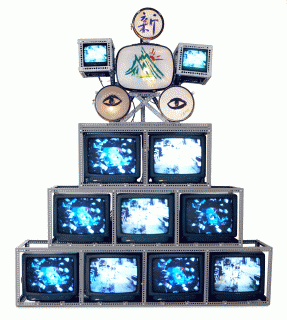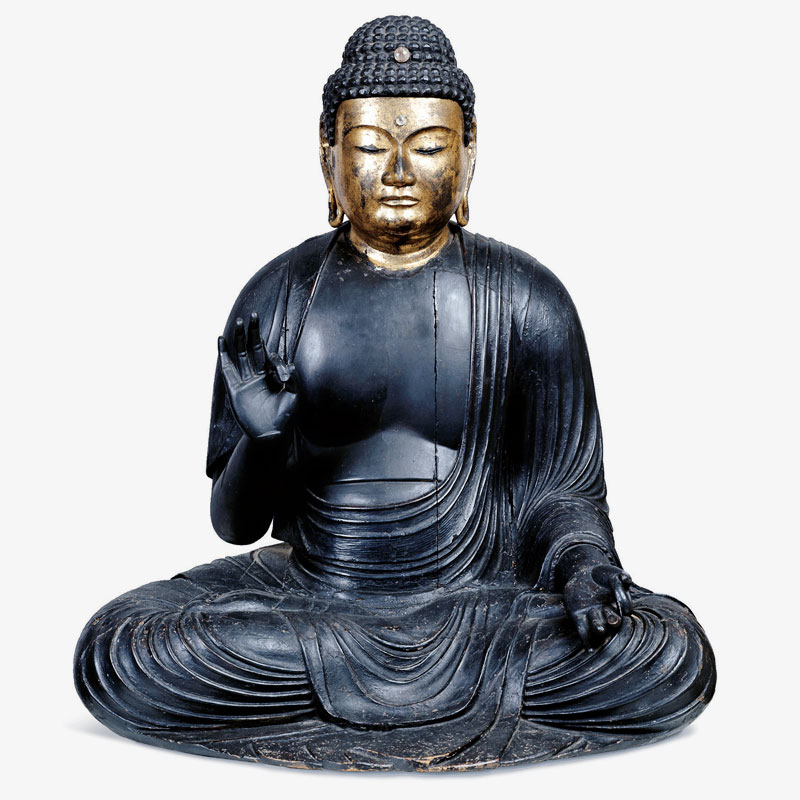
Nam June Paik
Four Decades
(1932–2006)
American, born Korea 1989, Video installation with software by Jud Yalkut (American, 1938-2013), 96 x 80 x 23 1/4 inches (243.8 x 203.2 x 59.1 cm). Gift of Society Bank through exchange, 1999.123
I See You
Playful. Subversive. Unpredictable. Nam June Paik used new technology, such as video, to explore old questions and challenge conventional thinking. Take a closer look at Four Decades and expand what you think art can be.
A Day in the Life
Tools and Techniques
Behind the Scenes
Routine Maintenance
Look closer at the screens. Are they all working? Unlike most of the other artworks at The DAI, which are made of relatively stable organic materials, Four Decades uses electronic components that may break or become obsolete. This presents unique maintenance challenges. Originally, there were two 9-inch KEC televisions and nine 19 ½-inch Samsung televisions. The video program was originally played on two LaserDisc players.
Keeping the monitors on for long periods of time during opening hours is hard on them. With changes in monitor technology it is increasingly difficult to find replacement cathode ray tube (CRT) monitors that have a similar size to fit in the unique metal structure, and appearance to match with the other monitors. The video program has since been transferred to DVD.
It seems Paik foresaw some of these problems. The DAI has a signed statement from him detailing what sorts of updates and modifications can be made for the work to still be considered authentic. As you look at Four Decades, what do you think makes it authentic? Is it maintaining all of the original parts? Using the best technology to present the visual content? Is the artistry in the material or the idea?
Thank you to Martin Pleiss, Exhibition Designer and Chief Preparator at The DAI, for supplying information on the maintenance of Four Decades.
Look Closer
Just for Kids
Signs & Symbols
Dig Deeper
Arts Intersected
The Sculpture Speaks
Did You Know?
Expert Opinion
Look Around
Electronic Enlightenment
Buddhism is a recurring theme in Paik’s art, such as his Zen for Film (1962), a 20-minute, unexposed reel of film that subtly shows changing patterns of light based on the dust and scratches that accumulate on the film. Another example is Paik’s Buddha Watching TV, one of a series of multi-media works that transpose traditional Buddhist imagery into a modern context. You can see one example at the Virginia Museum of Fine Arts here.
Four Decades also draws on Buddhism. As you watch the video, look for images of Buddhist subjects, such as monks, lotus flowers, or statues. Also, the sculpture as a whole is arranged like a seated Buddha figure. Compare this with a more traditional Buddha in The DAI, such as the Amida Buddha in Gallery 107. Try to find visual similarities between the two, and consider what Four Decades might be saying about the nature of the Buddhist pursuit of Enlightenment in the midst of an electronic media-saturated environment.

Japanese, Amida Buddha, 12th–13th century, wood with lacquer and gilt, 35 x 30 x 26 inches. Gift of Mrs. Harrie G. Carnell, 1935.1
About the Artist
Thinking Backwards and Forwards
Nam June Paik was born in Korea, studied music at Tokyo University in Japan, began his art career in Germany with the Fluxus art movement, and settled in New York. Paik’s work is similarly wide-ranging. Learn more about his experimental approach to art and life in the following interview with Ken Hakata, Paik’s Nephew, and Sook-Kyung Lee, Research Curator at the Tate Research Centre: Asia Pacific.
© 2015 Tate
Transcript:
Ken Hakata: We used to call Nam June my “crazy” uncle. He was a great uncle to have, because he wanted me to watch more TV. And, I used to be a really bad piano student who had to take piano lessons; he took our family piano and destroyed it on stage, so no more piano lessons!
Sook-Kyung Lee: Nam June Paik was a pioneer of video and new media art, and he was one of the most innovative artists of the 20th century. He was really quite a visionary, using ideas like electronic superhighway, and technologies such as television sets, lasers, [and] CCTV systems.
Ken Hakata: He’s really influenced not just the new generations of artists, but really popular culture. When you go to the fashion stores, when you go to these designer stores, a lot of the displays for a long time looked like Nam June pieces with all the big television pieces all over the place. MTV is very much like Nam June’s videos, and he’s not just global as an artist, but he foresaw the globalization of everything: art, commerce, travel; everything.
Sook-Kyung Lee: Paik was quite a good collaborator, not just with artists but with engineers and technicians. Japanese engineer Shuya Abe worked with Paik for many, many years. They were together developing new types of machines—synthesizers—which can manipulate images on TV. Although Paik is largely known as the sort-of pioneer of new media art, he used conventional artistic mediums as well, such as paintings and drawings. It was really his experimental spirit and aesthetics which set him apart from other artists of the same age.
Ken Hakata: I was really fortunate in watching Nam June physically make things. For example, there’s a can car, which he made in my bedroom in Tokyo. The wheels on the can car and the motor come from my toys. My uncle told me you should experience everything once, and I think that he gave my mind great flexibility in thinking of everything backwards and forwards, sideways; and maybe that’s why I’m not shocked by many things in life, because I may have learned that from my uncle.
Talk Back
Eye to Eye
In 1974 Paik coined the phrase “electronic superhighway,” and throughout his career he explored new technology from different angles. We say that we “watch TV,” but the two eyes on top of Four Decades suggest somebody else may be watching. What could the eyes represent? How might Four Decades make you think differently about the way humans interact with visual media?
